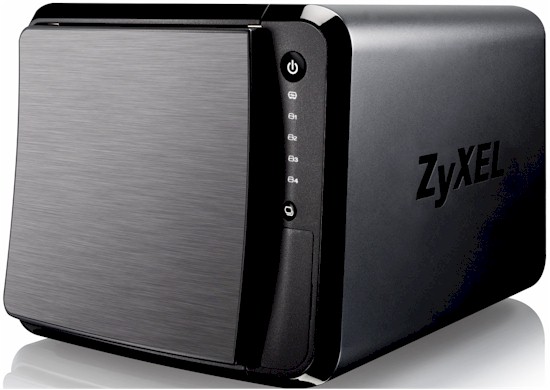
| At a glance | |
|---|---|
| Product | Zyxel 4-Bay Personal Cloud Storage (NAS540) [Website] |
| Summary | Four-bay dual core Freescale-based NAS with loadable apps and cloud access. |
| Pros | • Dual Gigabit Ethernet ports • Quiet and Eco friendly • 3 USB 3.0 ports and 1 SD card slot • Personal cloud features |
| Cons | • No audible alarm or front panel indication of RAID failure • Relies on UPnP port forwarding for remote access • No iSCSI support |
Typical Price: $200 Buy From Amazon
Introduction
The NAS540 4-Bay Personal Cloud Storage is ZyXEL’s first four bay NAS. Like the two-bay NAS325 V2, the NAS540 offers lots of features and decent performance at a nice low price.
The NAS540 offers all the features you’d expect in a 4-bay NAS. It supports RAID 0/1/5/6/10 and RAID5 + Hot Spare volumes and accepts both 3.5″ and 2.5″ SATA drives in hot-swappable bays.
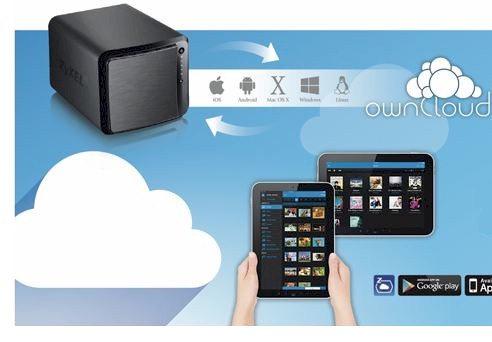
ZyXEL NAS540
The NAS540 is the first ZyXEL product with “personal cloud” features. So we’ll be taking a look at these features and the slightly updated UI based on ZyXEL’s NSM 5.0 (NAS Station Management) OS.
Like many other 4-bay NASes, the drives in the NAS540 are mounted vertically. The NAS540 measures 7.48″ x 8.85″ x 6.29″ and weighs about 4.4 lbs without disks. The callouts below show the front and rear panels.
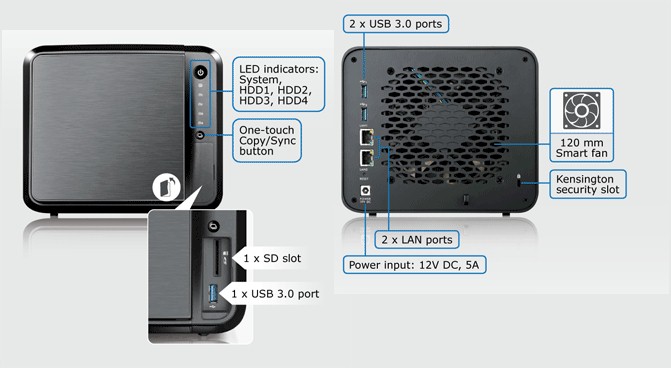
ZyXEL NAS540 front and rear panel callouts
It’s worth noting that of the four least expensive 4-drive NASes we’ll be including in our comparisons in this review, only the NAS540 has three USB 3.0 ports as well as an SD card slot. It also has two Gigabit Ethernet ports – a feature shared only by the recently reviewed D-Link DNS340L.
The front panel is relatively plain. It features a power on/off switch, a system LED and individual LEDs for each drive. The One-touch Copy/Sync allows you to initiate the copy or sync function of memory devices inserted into USB or SD ports. The front panel SD slot and 1 USB 3.0 port are covered by a hinged plastic door. The front panel that covers the drive bays is secured to the case with four corner-mounted magnets.
The rear panel has two additional USB 3.0 ports, dual Gigabit Ethernet ports, a Kensington security slot and a power input jack. The callouts for the power port contains an error. The NAS540 is powered by a 19 VDC 4.7 A external “brick” power supply. The external power supply helps reduce the heat inside the case. ZyXEL touts the 120 MM Smart fan as a contributing factor to the NAS’s low noise. Indeed, in our tests, the NAS540 earned a "low" noise rating. Not identified in the rear panel callout above is a reset switch. It’s located just above the power socket.
Inside
The NAS540 is powered by a 1.2 GHz dual-core Freescale FS1024 (M86203G12) SoC with 1 GB of DDR3 RAM and 256 MB of Spansion Flash. The Gigabit Ethernet ports are a pair of Realtek RTL8211E.
Since there are no other Freescale powered four-bay NASes in our current NAS Charts, I’ll be comparing three other least expensive four-bay NASes, i.e. the ASUSTOR AS-204TE, Thecus N4310 and D-Link DNS-340L. Key components for all four products are shown in Table 1.
| ZyXEL NAS540 | D-Link DNS-340L | ASUSTOR AS-204TE | Thecus N4310 | |
|---|---|---|---|---|
| CPU | Freescale FS1024 (M86203G12) Dual Core @ 1.2 GHz | Marvell Armada 370 88F6707-A1 C120 @ 1.2GHz | Intel Atom CE5310 @ 1.2 GHz (dual core) | AMCC APM86491-RKB1000T 1GHz SoC |
| RAM | 1 GB DDR3 | 512 MB Hynix H5TQ2G83FFR ?512 MB DDR3 (x2) | 1 GB DDR3 on board | 1 GB DDR3 Sk Hynix H5TQ4G43AFR (x2) |
| Flash | 256 MB Spansion S34ML02G100TFI000 | 128 MB Hynix H27U2G8F2CTR | 16 MB Spansion FL128SAIF00 | 1 GB Spansion S34ML08G101TFI000 |
| Ethernet | Realtek RTL8211E Gigabit Ethernet (x2) | Marvell 88E1518 Gigabit Ethernet (x2) | Realtek RTL8211E | Atheros AR8035-A |
| USB 3.0 | USB 3.0: Asmedia ASM1074L 4 port USB 3.0 controller | Etron Tech EJ168A | Etron Tech EJ188H | None |
| SATA | Asmedia ASM1061 2 port PCIe to SATA – Pericom PI3EQX4951STZDE SATA2 ReDriver(x2) |
Marvell 88SE9215 4 port PCIe 2.0 SATA 6Gb/s and PATA Host Controller | Asmedia ASM1061 PCI Express to two ports of Serial ATA | JMicron JMB320 SATA II 3.0 Gbps port multiplier |
| Price | $231 | $292 | $351 | $199 |
Table 1: Key Component Summary and Comparison
The image below shows the NAS540 main board. In the center, the chip with the silver cover is the Freescale SOC. The Realtek RTL8211E Gigabit Ethernet controllers are on the left side of the board adjacent to the Ethernet connectors.
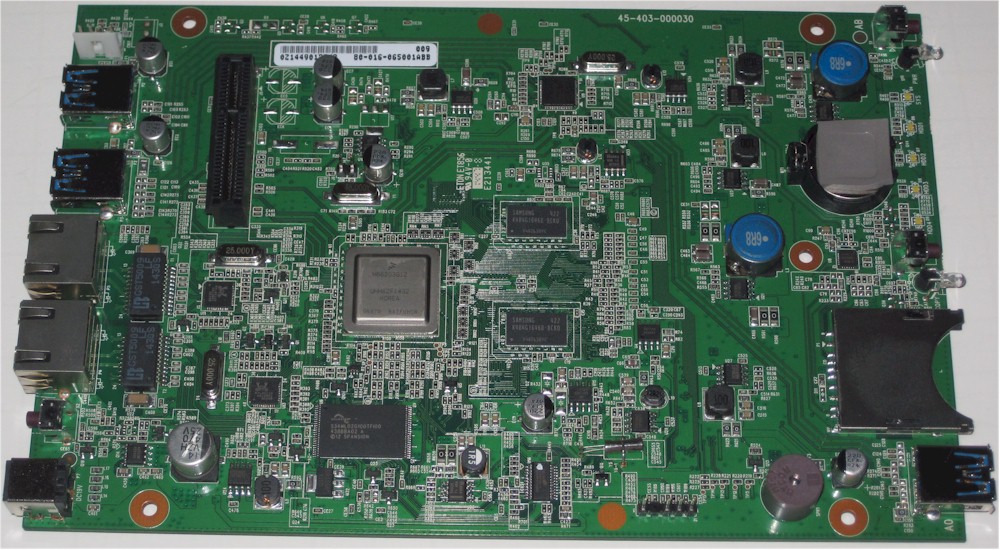
ZyXEL NAS540 Main PCB
The image below shows the drive backplane with four SATA connectors. It plugs into the connector near the upper left corner of the main board above.
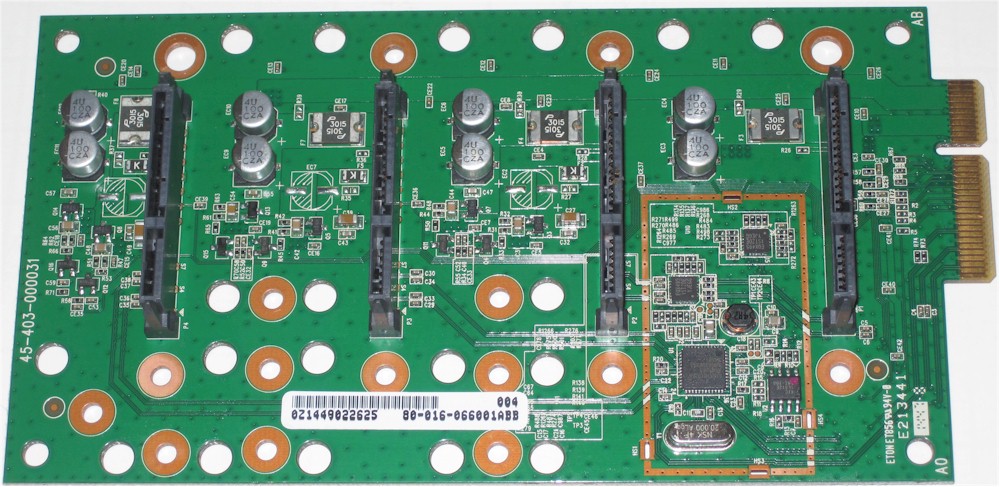
ZyXEL NAS540 backplane PCB
Setup
3.5″ disks are mounted in toolless trays using the same plastic mounting brackets that were first introduced in the NSA325 V2. 2.5″ disks still require screwing them to the tray.
The quickest way to configure the NAS540 is enter http://NAS540 into any web browser and log in using the default credentials admin / 1234. Alternatively, the Quick Start Guide gives you “Choice B”, which involves finding and downloading the NAS Starter Utility from the ZyXEL website.
The image below shows the NAS Starter utility. If you click on “NAS Seeker”, the utility will scan your network for a ZyXEL NAS. For a new NAS, the status will show as unconfigured.
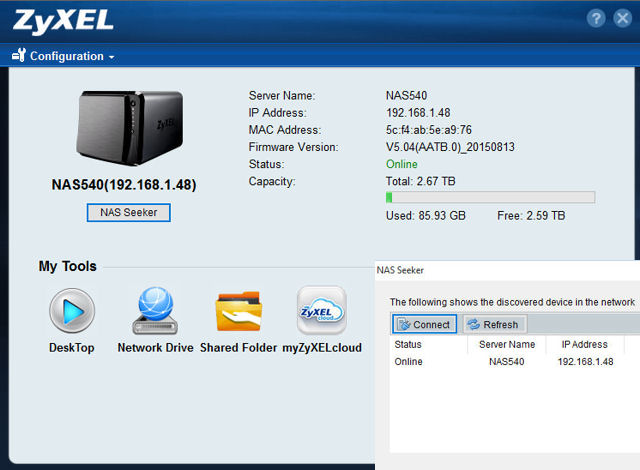
ZyXEL NAS starter utility with NAS seeker results (inset)
The inset in the lower right corner shows the NAS540 discovered on my network at 192.168.1.48.The four icons across the bottom of the screen do the following:
- Desktop – Click on desktop and after entering login credentials, you will be taken to the Web Configurator home page. Upon first landing at this page, you will be guided through setting up your NAS including configuration of your disks.
- Network Drive – Maps a drive letter to a share on the NAS
- Shared Folder – Shows all of the shared folders on the NAS.
- myZyXELcloud – Takes you to the myZyXELcloud login page.
The first time you go to the myZyXELcloud page, you will be prompted to use your Facebook or Google+ account, or create a myZyXELcloud account. This process also steps you through pairing your NAS540 with your ZyXEL account and setting up DDNS so that your NAS can be easily found on the Internet. The gallery below shows the configuration of myZyXELcloud.
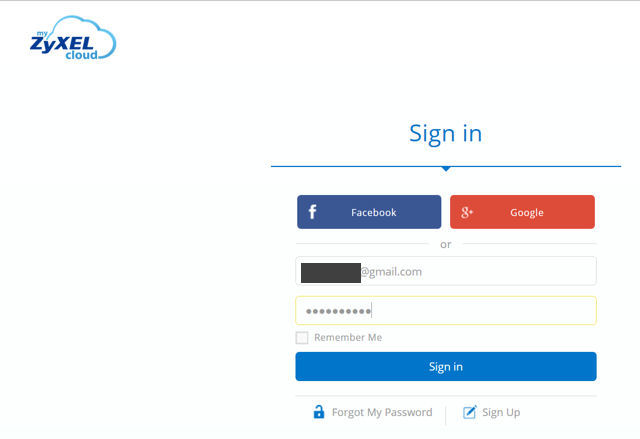
Use your Facebook or Google account or create a new Zyxel account
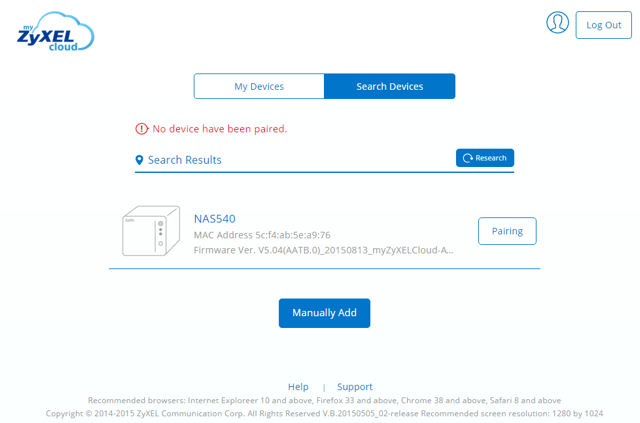
Unpaired NAS540 discovered
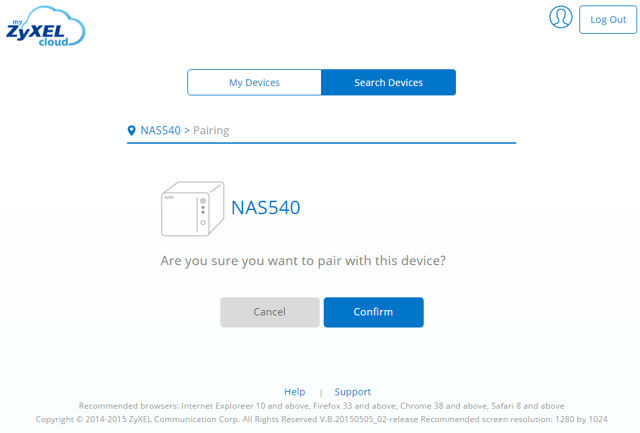
Confirm that you want to pair this device
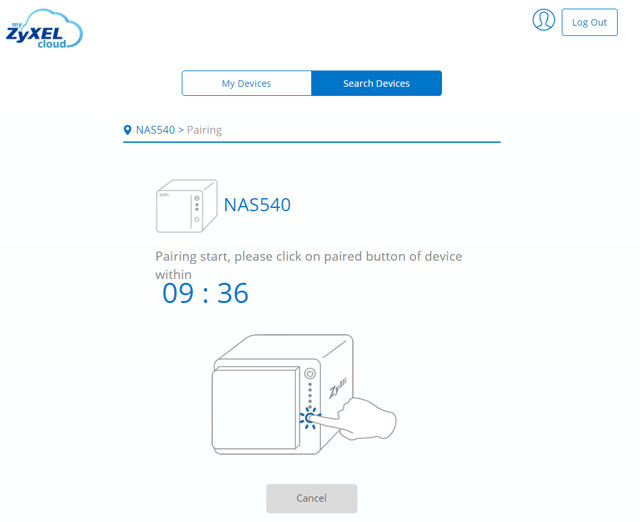
You have 10 minutes you must push the pairing button on the NAS540
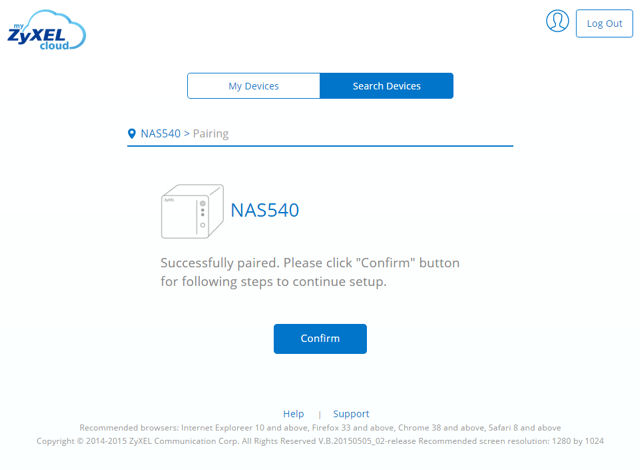
Click confirm to continue

Create a host name on the zyxel.me domain
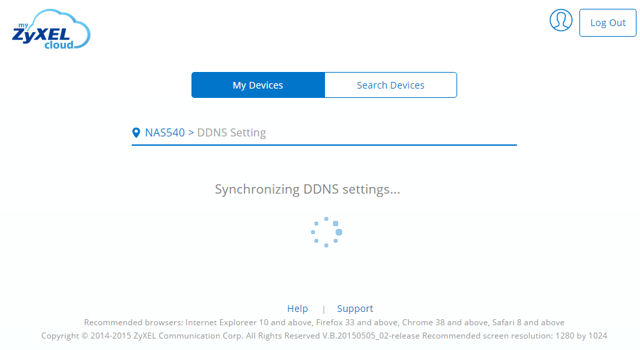
Settings synchronized
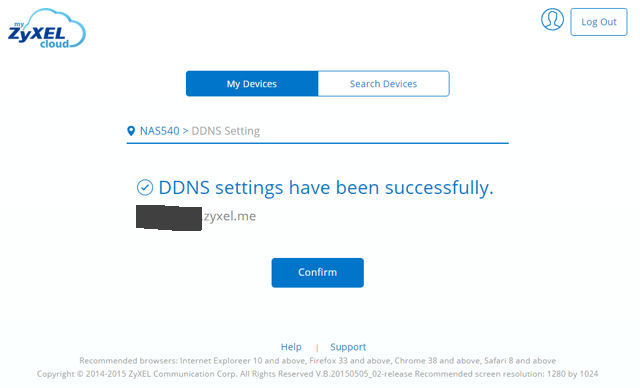
Click confirm to continue
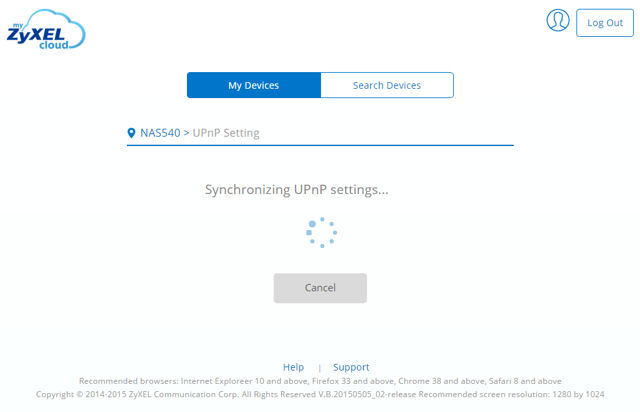
UPnP settings synchronizing
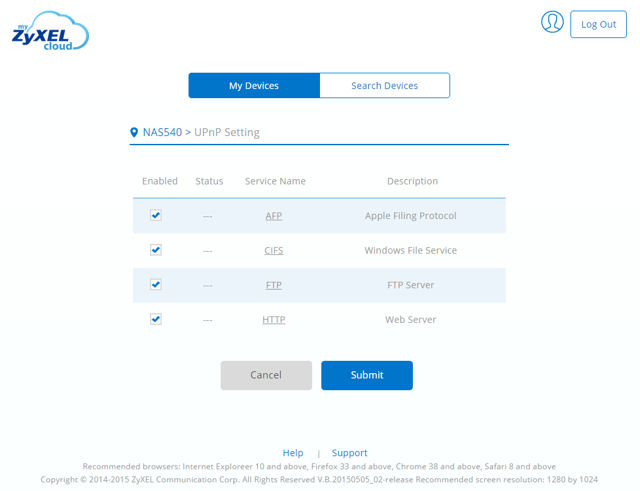
Click Submit to update
Features
The table below, taken from ZyXEL’s website, summarizes the features of the NAS540. You can find additional information on the NAS540 product page.
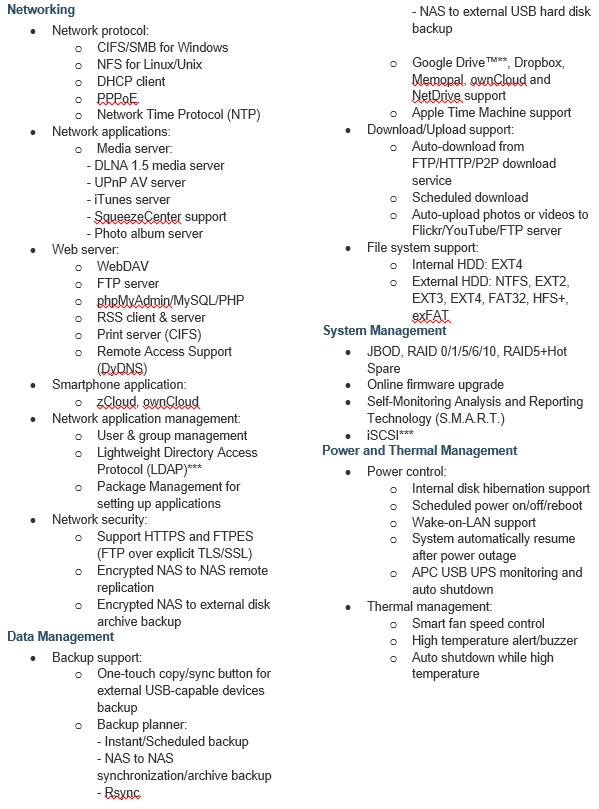
ZyXEL NAS540 features
When you log into the NAS540, you land at the page shown below. The page is fairly spartan with only a few icons. Annoyingly, the screen doesn’t resize very well. If you try to decrease the window size, scroll bars immediately appear. The four large icons function as follows:
- myZyXELcloud – clicking on this icon takes you to the same web location as the corresponding icon in the NAS starter utility above.
- Clicking on Storage takes you to the disk configuration page. This shortcut is duplicated by the disk icon in the task bar at the top of the screen.
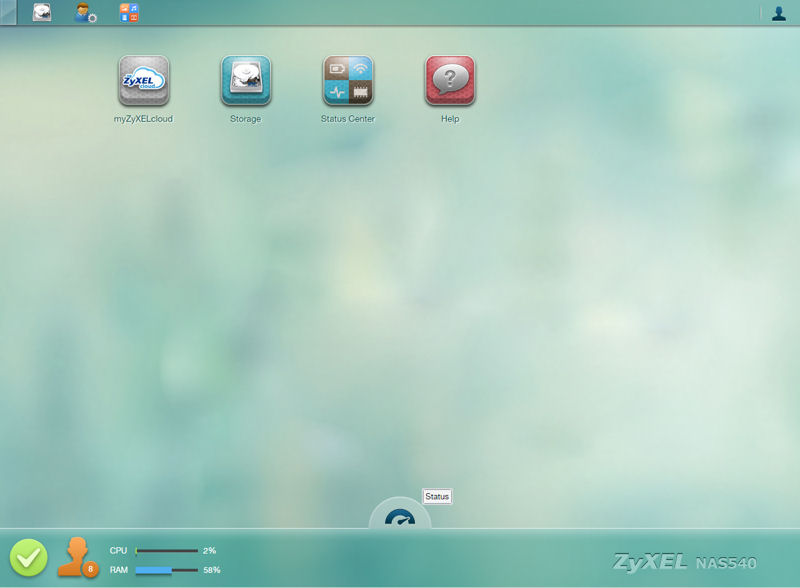
ZyXEL NAS540 Web Configurator landing page
- Status takes you to a status page, shown below, which only shows slightly more information than the status bar at the bottom of the screen.
- Help launches the help system, which is stored locally on your NAS.
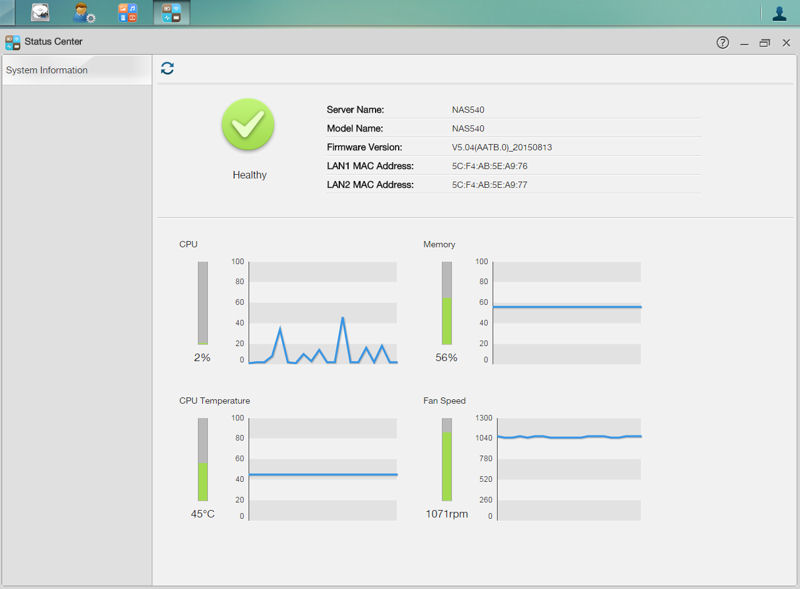
Zyxel NAS540 status page
At the top of the screen, the “people / gear” icon (second from left) launches the Settings menu. The next icon to the right launches the Playzone. Playzone, shown below, provides browser-based access to a file browser, photo viewer, music player and video player. Multimedia player features are basic, and, of course, you have to have appropriate playback plug ins installed in your browser for music and videos.
Also found in the Play Zone is the Application Zone. This shows you the installed apps on your NAS540 and lets you enable, disable, pause, resume or refresh each application. It also provides links to the management page for each app.
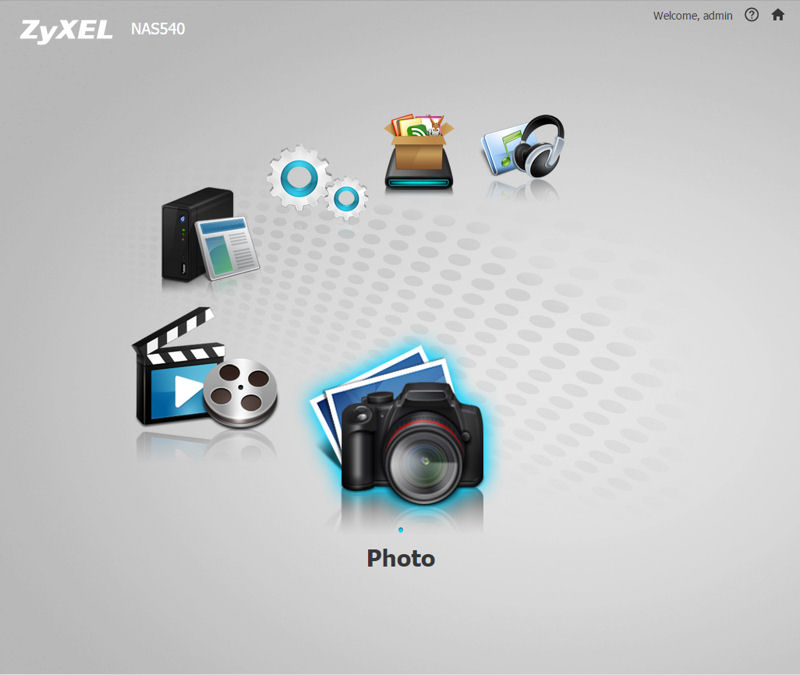
ZyXEL NAS540 Playzone landing page
Most of the changes you’ll make to the NAS540 are in the Administrator / Setup portion of the UI. As noted above, you access settings from the small gear icon in the top bar of the landing page. When you access Settings, you land at a Status page. Along the left vertical column, you’ll find collapsible categories of settings. To the right, you’ll find more detailed System information, volume status for external volume(s) and active sessions. In the screenshot below, there is currently one web-based admin session and three drive mappings.
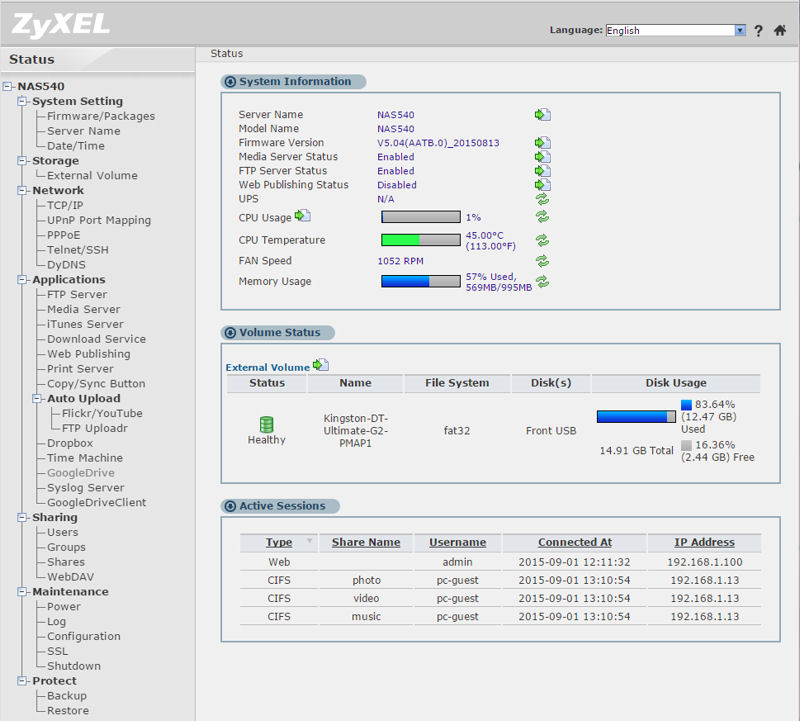
ZyXEL NAS540 Settings landing page
Many of the entries are self explanatory, and haven’t changed since we reviewed the NSA320. In the next section, I’ll focus on some of the features worthy of additional mention.
Hands On
Like many other NASes, the NAS540’s capabilities can be extended by the installation of packages. In the new OS, the packages are a little more difficult to locate because Apps aren’t on the home screen. Instead, you’ll find them buried under System Settings->Firmware/Packages->Package.
There are currently only 13 packages available. From the Package page, you can retrieve a list from the Internet, install/upgrade, uninstall/cancel installation, enable/disable and get package info. In the course of this review, I installed several packages including the Google Drive Client.
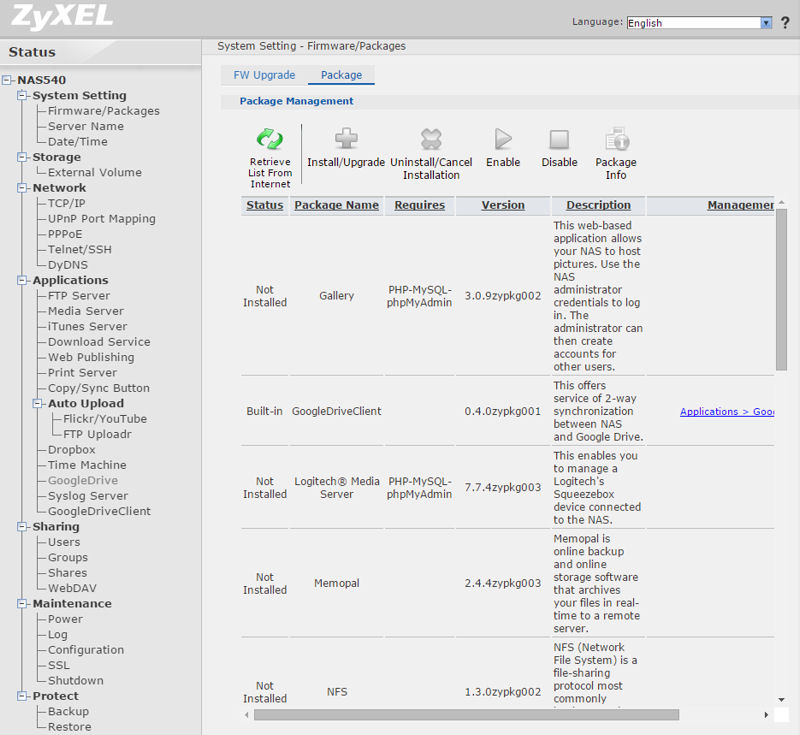
ZyXEL NAS540 Package Management
Media Server – The NAS540 includes a built-in DLNA media server. It uses a Twonky media server that can be managed via browser on port 9001 of your NAS. The image below shows the server successfully indexed 126 videos, 2331 tracks and 9040 photos.
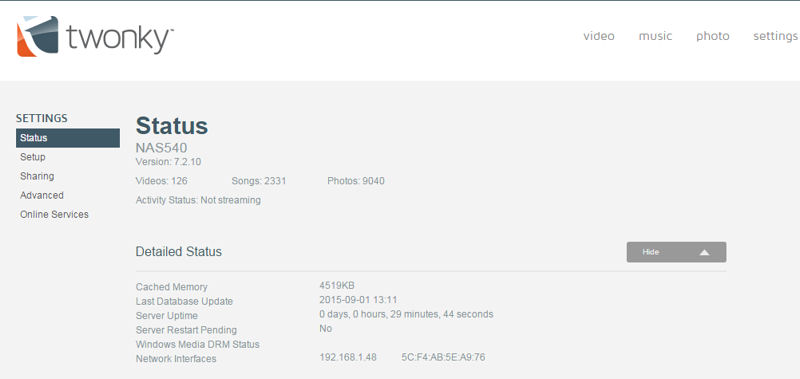
ZyXEL NAS540 DLNA Twonky Server console
One nice feature is the server automatically watches for new media and updates the index on the fly by default. There’s no need to set a scan interval unless you want to. I tested playing media content using several DLNA devices, including the WDTVLive I use for standard DLNA testing, as well as several DLNA apps on my iPad. As expected, I encountered no problems streaming video, audio or running slideshows on any of the platforms.
iTunes – like many NASes, the NAS540 has a built-in iTunes server. I enabled the server and tested it using iTunes on a Windows 10 system. iTunes found the server and was able to play the content back as expected.
GoogleDriveClient – This is a pretty useful application but not installed by default. During the configuration process, you specify a target volume \ folder on the NAS. Google will generate and display an authentication key that you enter into one of the final configuration screens.
Once configured, this application does a true two-way synchronization between the specified volume \ folder on the NAS and your Google drive account. File additions or deletions in either location are automatically synchronized. Testing found it worked exactly as expected. This could be a very handy feature if you already back up photos or other mobile data to Google Drive. I’ve set up a short gallery to show you the configuration process for Google Drive Client.

Use your Facebook or Google account or create a new Zyxel account

Unpaired NAS540 discovered

Confirm that you want to pair this device

You have 10 minutes you must push the pairing button on the NAS540

Click confirm to continue

Create a host name on the zyxel.me domain

Settings synchronized

Click confirm to continue

UPnP settings synchronizing

Click Submit to update
Dropbox – This application is not the equivalent of GoogleDriveClient for DropBox. When you log into your Dropbox account from the app for the first time, you have to grant permission to allow the NAS540 to access files and folders in Dropbox. Two directories are created in your Dropbox folder: Drop2NAS and zDownload.
Drop2NAS – According to the documentation, the NAS540 connects to Dropbox and copies files in the Drop2NAS to its admin\dropbox\FromDropbox. It then empties the Drop2NAS folder. This helps keep your DropBox cloud storage clean, and ensures that you have a copy on your NAS.
zDownload – here’s what the documentation says about the zDownload folder:
The NAS540 copies *.torrent files in the zDownload folder to the NAS’s admin\download\torrents folder and automatically starts downloading them. The NAS adds a suffix to the name of each torrent file in the Dropbox account’s zDownload folder and keeps updating it to show the job’s state. (downloading, queued, paused, canceled, uploading, finished, error, or retrying). The NAS does not take any action for folders nor other types of files in the zDownload folder.
Unfortunately, it doesn’t look like you have the ability to change the default download directory.
Copy/Sync Button – This feature allows you to copy to/from a USB storage device and the NAS540. To activate this feature, you select a NAS copy Target on the NAS, specify the USB volume and choose the copy direction – either USB->NAS or NAS->USB. A short press and release of the Copy/Sync button on the front panel of the NAS540 starts the copy process.
If you press the button until you hear a beep, you start the synchronization process. You have similar synchronization options: USB->NAS or NAS->USB. In addition, you can sync NAS<->USB with the option of backup files to be replaced or removed. The screenshot below shows the Copy/Sync button configuration screen showing the drop down Sync Direction choices.
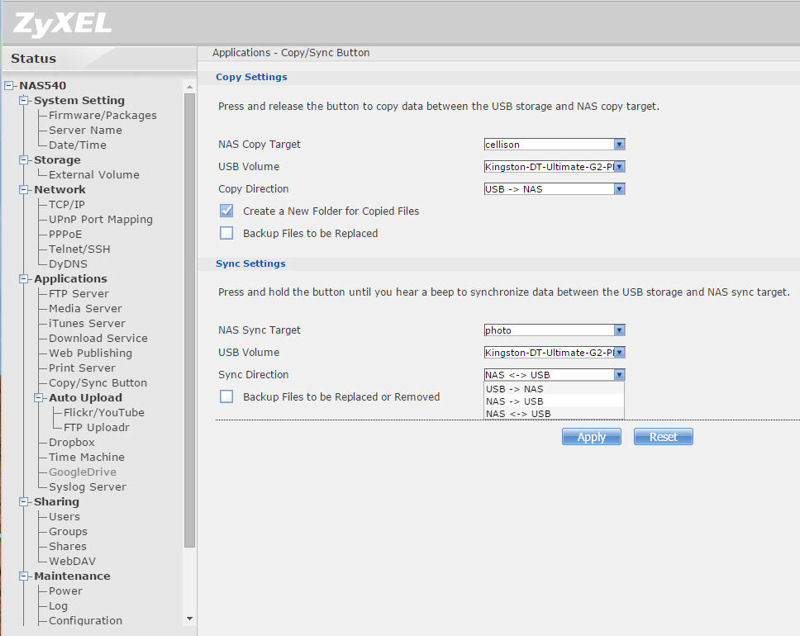
ZyXEL NAS540 Copy/Sync button configuration
I tested this feature and specified a USB->NAS copy of about 14 GB from a flash drive inserted into the front panel USB 3.0 slot. All files were copied into a new folder with a name using date and time format (2015-08-31_25_06_35).
ZyXEL zCloud Mobile Apps – Any NAS with “Personal Cloud” as part of its product name provides mobile apps so you can enjoy your media content from anywhere. Unlike some NAS manufacturers that have separate applications for video, audio, photos, file access, etc., ZyXEL has one app each for iOS and Android. You can download them at either the Google Play Store or the Apple App Store, or use one of the QR codes below.
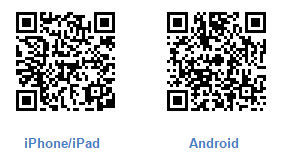
ZyXEL zCloud QR Code for iOS and Android
Both the iOS and the Android apps have similar feature sets, letting you play photos, music and video and browse files. You can also download any of the multimedia content on your NAS, or you can upload photos from mobile device. The file browser shows all your available shares and you have normal move, copy, delete, and rename options. You can also download or share files.
While both apps have similar features, the user interface is not consistent between the platforms. I found the iOS app easier to use. For example, sorting options appear on the bottom of the screens for the iOS app. On the Android app, it’s a menu item.
If you are going to use the mobile apps to connect to your NAS540 remotely, you’ll want to run the myZyXELcloud setup shown in Gallery 1 above. As noted, setup will create a DDNS account and attempt to set up port forwarding. ZyXEL relies on UPnP to open ports on your router and to redirect internet traffic intended for your NAS540 to the IP address of the NAS.
If you have UPnP disabled, you’ll have to manually set up port forwarding on your router. In some cases, like mine, I have another network device that is already using port 80, so I had to set up an alternate HTTP port (ZyXEL recommended 8080). Normally, I keep UPnP disabled, but for testing, I turned it on so that it could properly self configure.
Once configured, you log into the NAS540 using either the Android or the iOS app. If you are on the same local network as the NAS540, either app will discover your NAS540 and prompt for your username / password. If you are attempting to connect to the NAS540 from a remote network and have set up myZyXELcloud, the host name will be in the format of username.zyxel.me. Of course, you can set up DDNS using other domains under Network->DDNS. If you have specified an alternate HTTP port for the NAS540, your host name will be in the format username.zyxel.me:port number.
The Android app will let you sort music by Folders, Artists or by track name. You can select individual tracks and add them to a playlist, but there doesn’t appear to be a way to save the playlist. Selected files can also be downloaded to your Android device. For photos, you can sort either by date or folders. You can select individual images and play them in a slide show or download them from your NAS540. You can also upload photos to from your Android device to your NAS540. Slideshows of folders of selected images are supported.
Similarly, for video, you can sort by title or folders. You can select one or more files to download from your NAS540 or you can view your video. All of the features worked either on the local LAN or when connected via a remote network. I did run into video playback problems on my Android tablet, but that problem was probably related to the installed players on the device. I also installed the zCloud app on my Samsung S5 and video played back without a hitch. The gallery below will give you a feel for the Android zCloud app.

Use your Facebook or Google account or create a new Zyxel account

Unpaired NAS540 discovered

Confirm that you want to pair this device

You have 10 minutes you must push the pairing button on the NAS540

Click confirm to continue

Create a host name on the zyxel.me domain

Settings synchronized

Click confirm to continue

UPnP settings synchronizing

Click Submit to update
I installed the iOS device on my iPad and did my initial testing on that platform. While the application performed as expected on the local network, initially I had difficulty getting it to connect using a remote network – even though the Android app connected from the same remote network using the same host name and login credentials. At ZyXEL’s recommendation, I uninstalled and reinstalled the iOS zCloud app, and that seemed to fix the problem. As noted, the features in iOS are very similar to those found in the Android app, but I found the UI on the iOS a little easier to use. Below you find a short gallery of screenshots from the iOS version of zCloud.

Use your Facebook or Google account or create a new Zyxel account

Unpaired NAS540 discovered

Confirm that you want to pair this device

You have 10 minutes you must push the pairing button on the NAS540

Click confirm to continue

Create a host name on the zyxel.me domain

Settings synchronized

Click confirm to continue

UPnP settings synchronizing

Click Submit to update
Drive Pull
As with all fault-tolerant NASes, I performed a “drive pull” test on the NAS540. The NAS540 was configured for RAID 5 and had about 70 GB of data copied onto it. I initiated a file copy to add some additional music to the NAS, then unplugged drive 2 during the file copy. While the file copy continued, the LED indicator corresponding to drive 2 turned red. That was the only indication there was a degraded condition; there was no audible alert. Logging into the NAS, there is no indication anything is amiss. You have to navigate to Storage Status to see the Volume marked as being degraded. By looking at the drive list, I could see drive 2 was missing.
I let the file copy continue until it had completed, then re-inserted drive 2. While some NASes automatically start a RAID rebuild, the NAS540 takes a more conservative approach. Through the Storage menu, when a new drive is inserted, a “repair volume” appears. When you click on that option, the next page shows which disk is missing, and which disk is available to repair the volume. I repaired the volume.
RAID rebuild took a bit over three hours to return the volume to “Healthy” status. According to ZyXEL, the length of time required to rebuild (resync) is a function of the size of the disks, and how much data needs to be resynced. I was pleased to see the log file recorded storage related events including the drive failure, replacement and successful rebuild. The short gallery below shows the RAID failure notification and resync sequence.

Use your Facebook or Google account or create a new Zyxel account

Unpaired NAS540 discovered

Confirm that you want to pair this device

You have 10 minutes you must push the pairing button on the NAS540

Click confirm to continue

Create a host name on the zyxel.me domain

Settings synchronized

Click confirm to continue

UPnP settings synchronizing

Click Submit to update
Performance
Performance tests were run using the Revision 5 NAS test process with firmware version V5.04(AATB.0)_20150813. All tests were run using Western Digital Red 1 TB (WD10EFRX) drives ZyXEL supplied with the test sample.
For Benchmark Summary and NAS Ranker performance comparisons, I compared the least expensive NAS, the Thecus N4310 and the next most expensive NAS, the D-Link DNS-340L. The Benchmark Summary shows all test results for each product.
In reviewing the charts below, a few things stand out. First, there aren’t NAS540 test results for iSCSI because the product doesn’t support iSCSIyet. ZyXEL says iSCSI support is slated for sometime later this year. Second, the ZyXEL NAS significantly outperformed the other two for USB 3.0 backup for FAT, NTFS and EXT3 file formats. In fact, depending on the file format and which other NAS you compare, the ZyXEL had 2-3 times the backup throughput for attached storage.
Network backup, however, was a different story. The NAS540 achieved only 18.4 MB/s compared to Thecus’ 42.5 MB/s and D-Link’s 33.1 MB/s. If you do a line-by-line comparison of all 33 tests (excluding iSCSI), you’ll discover that the ZyXEL had the best score on 24 tests, compared to D-Link’s 3 top scores and Thecus’s 6 top scores.
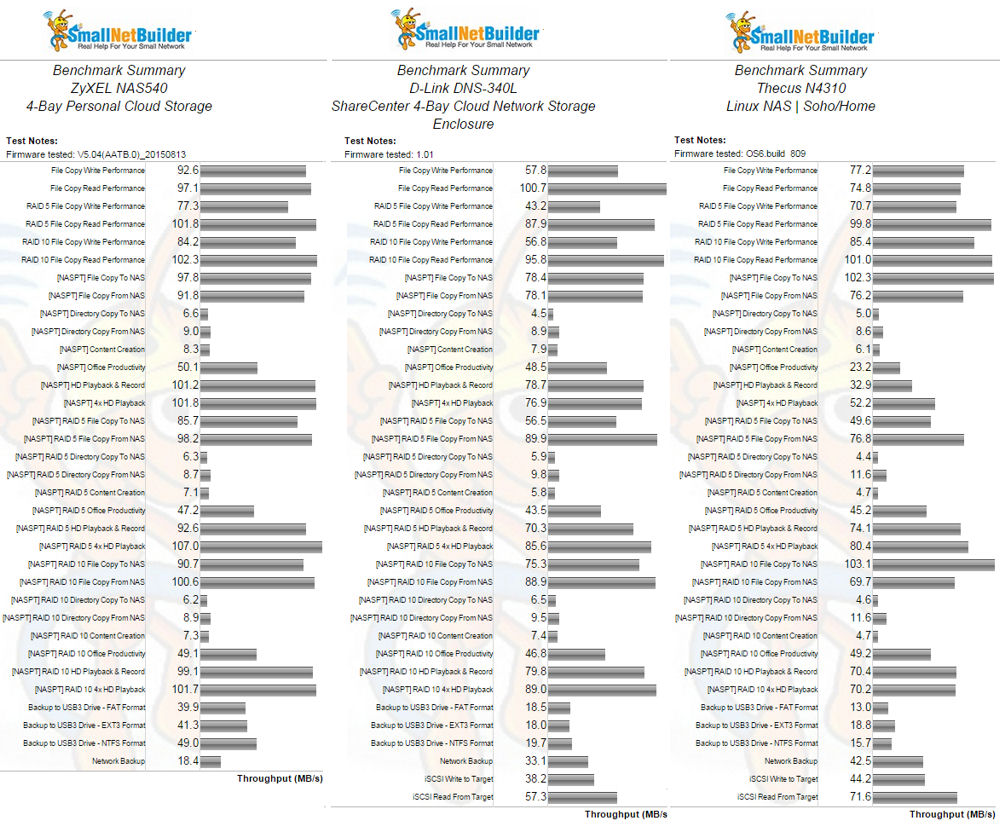
Benchmark summary comparison for Zyxel NAS540 (left), D-Link DNS-340L (center) and the Thecus N4310 (right)
Since buyers are usually looking for best bang for the buck, I took our usual approach of sorting the NAS Ranker‘s results by ascending price. The chart below shows the Thecus and D-Link tied for number 18 (last).
What’s important in this chart, however, is that the second least expensive ZyXEL NAS540, priced at $231 at time of review, came in at #15. This means it not only outperforms the Thecus N4310 and D-Link DNS-340L, but also the much more expensive ASUSTOR AS-204TE at $351. To move up a notch in performance to #14, you’d have to spend around $10 more for the ASUSTOR AS-304T.
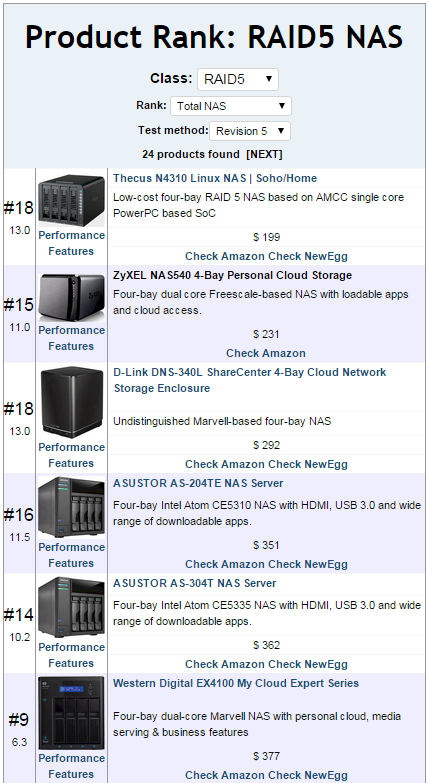
NAS Ranker filtered for RAID5 showing Total NAS ranking sorted on ascending price
Most of the improvements in performance can directly attributed to faster processors and/or more memory. Both the Thecus and the D-Link NASes use a single core processor. The next most expensive NAS, the ASUSTOR AS-204TE uses an Intel Atom CD5310 and the AS-304T uses an Intel Atom CE5335 – both of which are dual core processors.
Drilling down into the performance of the three NASes allows us to look at individual and category comparisons. The composite chart below shows the detailed performance for the ZyXEL NAS540 (left), D-Link DNS-340L (center) and the Thecus N4310 (right). Of the three compared products, the NAS540 had the best (lowest numbered) ranking in every category.
While the overall ranking for the ZyXEL was #15, on some individual test results, the ranking was up in single digits. For example, for RAID 10 Windows File Copy Read and NASPT RAID 10 File Copy from NAS, the NAS540 ranked #2. Undoubtedly it tied with the more expensive NASes, as the performance was at or near the maximum throughput of a Gigabit Ethernet connection.
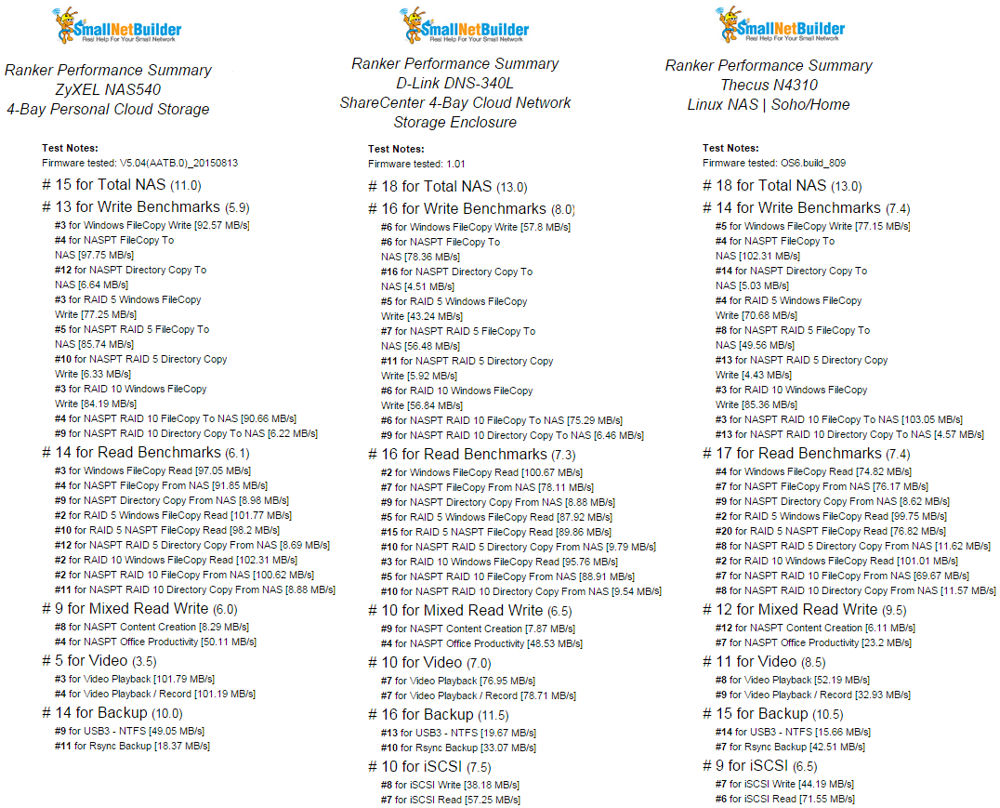
Ranker performance comparison for the ZyXEL NAS540 (left), D-Link DNS-340L (center) and the Thecus N4310 (right)
Closing Thoughts
With the NAS540, ZyXEL continues its tradition of offering NASes that offer a lot of features and decent performance at entry level prices. As shown in the NAS Ranker above, to move up to a product with a higher Total NAS ranking, you’d have to spend about 50% more than the NAS540’s current $231 price. The chart also shows that it clearly outperformed the cheapest 4-drive NAS (Thecus N4310) and the next two most expensive NASes – the D-Link DNS-340L and ASUSTOR AS-204TE.
But the NAS540 has its weaknesses. It earns our standard criticism given to any "cloud" product that doesn’t use a relay server for easy remote access. Relying on port forwarding and especially automatic port opening via UPnP, which many security conscious users disable, for remote access is not user friendly. It also can’t handle cascaded NAT networks created by using a router behind ISP-provided modems that usually have their own built-in routers.
Compared to other NASes, the NAS540 also falls somewhat short when it comes to its library of installable apps. QNAP and Synology, for example, have significantly larger libraries of both manufacturer-developed and third party apps available. Finally, ZyXEL needs to do a better job of indicating volume failures and corruption; simply changing the color of a front panel light doesn’t cut it.
I like that ZyXEL has been able to successfully integrate music, photo, video and file browsing capabilities into a single app. However, both the iOS and Android versions of the zCloud app lack the capability to automatically back up photos to the NAS540. For that feature, ZyXEL is currently depending on an installable third party app, ownCloud for photo backup. The package is open source and there’s a lot of available documentation to wade through. Fortunately, ZyXEL has condensed that into a Knowledge Base article that can help you through setting up myZyXELcloud and using ownCloud. ZyXEL told us their current product road map includes adding photo backup in a future version of zCloud, but with no specific timeline.
With features and performance approaching mid-range NASes, the ZyXEL NAS540 is an excellent choice for buyers on tight budgets looking for a RAID 5 capable NAS.
